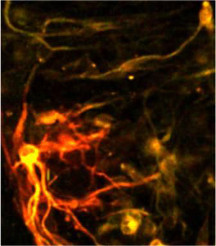Brain tumor cells interconnect to a functional and resistant network
 Astrocytic brain tumours, including glioblastomas, are incurable neoplasms characterized by diffusely infiltrative growth. Here we show that many tumour cells in astrocytomas extend ultra-long membrane protrusions, and use these distinct tumour microtubes as routes for brain invasion, proliferation, and to interconnect over long distances. The resulting network allows multicellular communication through microtube-associated gap junctions. When damage to the network occurred, tumour microtubes were used for repair. Moreover, the microtube-connected astrocytoma cells, but not those remaining unconnected throughout tumour progression, were protected from cell death inflicted by radiotherapy. The neuronal growth-associated protein 43 was important for microtube formation and function, and drove microtube-dependent tumour cell invasion, proliferation, interconnection, and radioresistance. Oligodendroglial brain tumours were deficient in this mechanism. In summary, astrocytomas can develop functional multicellular network structures. Disconnection of astrocytoma cells by targeting their tumour microtubes emerges as a new principle to reduce the treatment resistance of this disease.
Astrocytic brain tumours, including glioblastomas, are incurable neoplasms characterized by diffusely infiltrative growth. Here we show that many tumour cells in astrocytomas extend ultra-long membrane protrusions, and use these distinct tumour microtubes as routes for brain invasion, proliferation, and to interconnect over long distances. The resulting network allows multicellular communication through microtube-associated gap junctions. When damage to the network occurred, tumour microtubes were used for repair. Moreover, the microtube-connected astrocytoma cells, but not those remaining unconnected throughout tumour progression, were protected from cell death inflicted by radiotherapy. The neuronal growth-associated protein 43 was important for microtube formation and function, and drove microtube-dependent tumour cell invasion, proliferation, interconnection, and radioresistance. Oligodendroglial brain tumours were deficient in this mechanism. In summary, astrocytomas can develop functional multicellular network structures. Disconnection of astrocytoma cells by targeting their tumour microtubes emerges as a new principle to reduce the treatment resistance of this disease.
see more: http://www.nature.com/nature/journal/v528/n7580/full/nature16071.html
- 362 views
